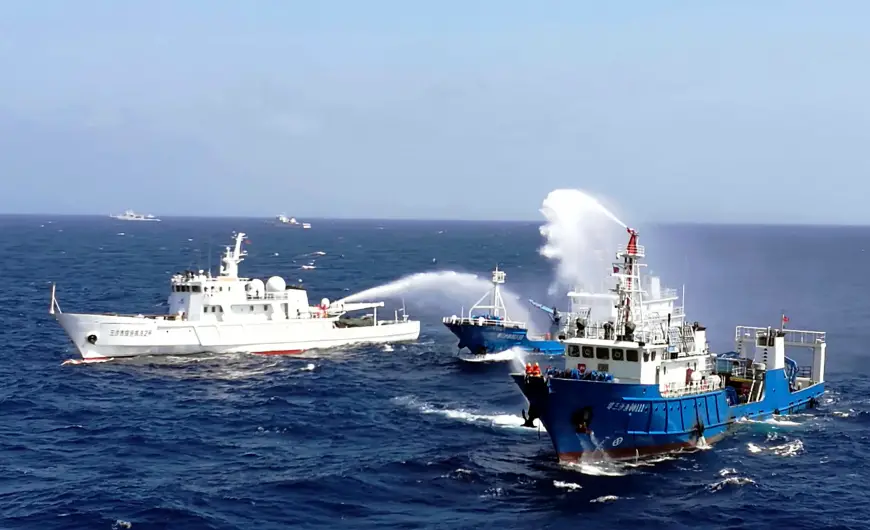South China Sea Standoff 2025: Escalation or Strategic Posturing?
In 2025, South China Sea tensions between the U.S. and China are surging—this article examines military maneuvers, diplomatic shifts, and war risks.

Growing Military Maneuvers
Recent weeks have seen a marked uptick in military activity in the South China Sea. On June 15, China's People’s Liberation Army (PLA) reported joint sea‑and‑air patrols near the Philippines, asserting its readiness to defend national sovereignty cfr.org+15reuters.com+15armyrecognition.com+15. Meanwhile, the Chinese navy has been conducting “combat readiness patrols” near strategic points like Huangyan Dao and Scarborough Shoal armyrecognition.com+1aljazeera.com+1.
In response, the Philippines and U.S. coast guards recently carried out their first combined military drills—involving naval ships, aircraft, and maritime tactics—off Palawan and Occidental Mindoro thedefensepost.com. This marks a significant shift in joint operational coordination within the region.
Diplomatic Fallout
Beijing reacted sharply, condemning the joint drills as a threat to “regional security.” The Philippines, in turn, documented repeated incidents of Chinese vessels impeding Philippine fishing and resupply missions—forcing diplomatic protests and reinforcing Manila’s appeal to international allies crisisgroup.org+11apnews.com+11responsiblestatecraft.org+11.
At the Shangri‑La Dialogue, U.S. Defense Secretary Pete Hegseth warned that China’s growing naval presence and emerging military technologies in the South China Sea pose an “imminent” threat, urging allies to increase defense spending cbsnews.com+6apnews.com+6theaustralian.com.au+6. China’s delegation accused the U.S. of inciting instability, deepening diplomatic tensions.
The Risk of Miscalculation
Analysts caution that the region has entered a “grey‑zone” posture—marked by assertive but non-lethal actions designed to test boundaries and erode opposing claims apnews.com. Close-quarters incidents remain common: rammings, water cannon deployments, and standoffs—including at Second Thomas Shoal—have previously escalated to violence thedefensepost.com+10quincyinst.org+10responsiblestatecraft.org+10.
This pattern increases the risk of accidental escalation. A misinterpreted collision or unplanned missile test could rapidly shift the region from diplomatic friction to armed confrontation.
Strategic Implications for Regional Security
1. U.S.–Philippines Treaty Obligations
Under a mutual-defense treaty, any armed attack on Philippine territory—including ships—could compel U.S. military involvement. The 2024 Second Thomas Shoal incident saw China’s coast guard use axes and water cannons on Philippine vessels, causing injuries crisisgroup.orgquincyinst.org+2en.wikipedia.org+2cbsnews.com+2.
2. AUKUS and Indo-Pacific Significance
Meanwhile, the U.S.–Australia–UK AUKUS partnership is under internal review. The Pentagon has signaled that Australia must increase defense spending to stay in the loop on nuclear submarine development theaustralian.com.au—a reflection of shifting strategic priorities toward the Indo-Pacific.
3. Economic and Strategic Ripple Effects
The South China Sea carries over $3 trillion in annual maritime trade. Persistent instability here risks disrupting global supply chains. It also raises stakes for ASEAN countries like Vietnam, which must recalibrate economic ties to buffer against heightened U.S.–China tensions reuters.com.
Escalation vs. Posturing: Where It’s Heading
-
Escalation Scenario: A collision or one miscalculated strike could trigger U.S. naval deployment, dragging coalition forces into a direct standoff with China.
-
Posturing Scenario: While aggressive, the current maneuvers may be designed to reinforce bottom lines without triggering open conflict—testing deterrents and international resolve.
Still, with the U.S. emphasizing deterrence while China speeds up campaigns near Taiwan and the South China Sea, the margin for error is shrinking .
Conclusion
The South China Sea in 2025 is evolving into a high-stakes strategic arena. China’s naval expansion and assertive patrol tactics are paralleled by U.S.–Philippines defense cooperation and broader AUKUS recalibration. As grey-zone provocations escalate, the threat of miscalculation rises—putting global commerce and military balance at risk.
The coming months may determine whether this is a prolonged show of force or a flashpoint for wider conflict. Policymakers must weigh restraint against deterrence—knowing that a single incident could reshape Asia-Pacific security for years.














